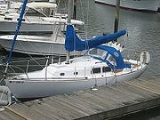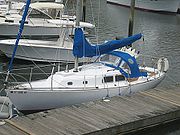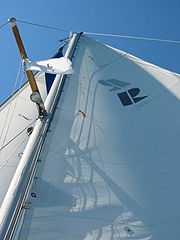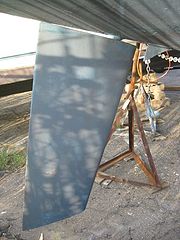
Pearson renegade
Encyclopedia
The Pearson Renegade is a 27' sloop
rigged sailboat produced by Pearson Yachts
of Bristol, RI from 1966-1969, with the first boats being sold in 1967. Designed by William Shaw, about 175 of the boats were built. They were Pearson's first split underbody boat and were designed to Cruising Club of America
racing rules. They are also one of the first American "racer-cruiser" style boats that combine the comforts of a cruising boat with the advantage of a modified full keel
with a spade rudder
(see photo), like that of the Bill Lapworth Cal 40 designs that revolutionized ocean racing in the mid-late 1960s. The keel allows the boat to track well and have good stability. The deep balanced rudder allows a high degree of maneuverability, and the turning radius of the boat is very tight. They contiunue to be a sought after boat because of their stout construction and kindly sailing ability.
Early versions had a traditional two settee salon, while boats produced in 1968 and after feature a more modern galley starboard and settee to port. Both have a spacious V-berth over six feet long and were available with either a 30-HP Universal Atomic 4
gas inboard or an outboard well. The cockpit can comfortably accommodate 4-6 people, and the boat can sleep 4 adults below decks. Standard steering on the boat was with a tiller, but many owners have installed after-market wheel steering. Other typical upgrades would include a roller furling
headstay to replace the original forestay
, and upgraded instrumentation such as depth, speed, and wind gauges, which did not come standard on the original boats. For more information on upgrades and projects on the Pearson Renegade, visit the Renegade homepage via the link at the bottom of the page.



----
Sloop
A sloop is a sail boat with a fore-and-aft rig and a single mast farther forward than the mast of a cutter....
rigged sailboat produced by Pearson Yachts
Pearson Yachts
Pearson Yachts was a small manufacturer of fiberglass sailboats built in Bristol, Rhode Island founded by cousins Clinton and Everett Pearson in 1956. The company is one of earliest fiberglass sailboat manufacturers. The Carl Alberg designed Triton 28 launched at the New York Boat Show in January...
of Bristol, RI from 1966-1969, with the first boats being sold in 1967. Designed by William Shaw, about 175 of the boats were built. They were Pearson's first split underbody boat and were designed to Cruising Club of America
Cruising Club of America
-History:It was launched in the winter of 1921-1922 by a handful of experienced offshore sailors interested in cruising and the development of the cruising type of yacht....
racing rules. They are also one of the first American "racer-cruiser" style boats that combine the comforts of a cruising boat with the advantage of a modified full keel
Keel
In boats and ships, keel can refer to either of two parts: a structural element, or a hydrodynamic element. These parts overlap. As the laying down of the keel is the initial step in construction of a ship, in British and American shipbuilding traditions the construction is dated from this event...
with a spade rudder
Rudder
A rudder is a device used to steer a ship, boat, submarine, hovercraft, aircraft or other conveyance that moves through a medium . On an aircraft the rudder is used primarily to counter adverse yaw and p-factor and is not the primary control used to turn the airplane...
(see photo), like that of the Bill Lapworth Cal 40 designs that revolutionized ocean racing in the mid-late 1960s. The keel allows the boat to track well and have good stability. The deep balanced rudder allows a high degree of maneuverability, and the turning radius of the boat is very tight. They contiunue to be a sought after boat because of their stout construction and kindly sailing ability.
Early versions had a traditional two settee salon, while boats produced in 1968 and after feature a more modern galley starboard and settee to port. Both have a spacious V-berth over six feet long and were available with either a 30-HP Universal Atomic 4
Universal Atomic 4
The Universal Atomic 4 is a four-cylinder, 64.46 cubic inch, gas engine produced by the Universal Motor Company between 1947 and 1984 for use as auxiliary power on sailboats. Over 40,000 of the engines were produced during that time, with an estimated 20,000 still in use today...
gas inboard or an outboard well. The cockpit can comfortably accommodate 4-6 people, and the boat can sleep 4 adults below decks. Standard steering on the boat was with a tiller, but many owners have installed after-market wheel steering. Other typical upgrades would include a roller furling
Roller furling
Roller furling is a method of furling or reefing wherein a sail is rolled around a stay or rotating spar. Roller furling is most commonly encountered on foresails, such as jibs, with mainsails a distant second.-Furling methods:...
headstay to replace the original forestay
Forestay
On a sailing vessel, a forestay, sometimes just called a stay, is a piece of standing rigging which keeps a mast from falling backwards. It is attached either at the very top of the mast, or in fractional rigs between about 1/8 and 1/4 from the top of the mast. The other end of the forestay is...
, and upgraded instrumentation such as depth, speed, and wind gauges, which did not come standard on the original boats. For more information on upgrades and projects on the Pearson Renegade, visit the Renegade homepage via the link at the bottom of the page.



Specifications
| LOA | 27'2" ft | |
|---|---|---|
| LWL LWL LWL is a three-letter acronym which can mean:* Landschaftsverband Westfalen-Lippe* Life-wide Learning* Waterline length* Left Wing Liberal* Life with Louie* Launceston Workplace Learning* laughing with lust* Little White Lies * Lead With Love... | 21" | |
| Beam Beam (nautical) The beam of a ship is its width at the widest point. Generally speaking, the wider the beam of a ship , the more initial stability it has, at expense of reserve stability in the event of a capsize, where more energy is required to right the vessel from its inverted position... | 8'7" | |
| Draft Draft (hull) The draft of a ship's hull is the vertical distance between the waterline and the bottom of the hull , with the thickness of the hull included; in the case of not being included the draft outline would be obtained... | 4'3" | |
| Displacement Displacement (fluid) In fluid mechanics, displacement occurs when an object is immersed in a fluid, pushing it out of the way and taking its place. The volume of the fluid displaced can then be measured, as in the illustration, and from this the volume of the immersed object can be deduced .An object that sinks... | 6500 lbs | |
| Ballast Sailing ballast Ballast is used in sailboats to provide moment to resist the lateral forces on the sail. Insufficiently ballasted boats will tend to tip, or heel, excessively in high winds. Too much heel may result in the boat capsizing. If a sailing vessel should need to voyage without cargo then ballast of... | 2100 lbs (Internal Lead) | |
| Head Room | 5' 10 | |
| Berth Berth (sleeping) The word berth was originally used to describe beds and sleeping accommodation on boats and ships and has now been extended to refer to similar facilities on trains, aircraft and buses.-Beds in boats or ships:... s | 4 | |
| Water Capacity | 20 gals. | |
| Fuel Capacity | 13 gals. | |
| CCA Rating | 22.6 app. | |
| Rigging Rigging Rigging is the apparatus through which the force of the wind is used to propel sailboats and sailing ships forward. This includes masts, yards, sails, and cordage.-Terms and classifications:... | Masthead Masthead -Media:* the masthead , a list, usually found on the editorial page of a newspaper or other periodical, listing the publisher, editorial board, advertising rates, etc.... sloop Sloop A sloop is a sail boat with a fore-and-aft rig and a single mast farther forward than the mast of a cutter.... | |
| Sail Sail A sail is any type of surface intended to move a vessel, vehicle or rotor by being placed in a wind—in essence a propulsion wing. Sails are used in sailing.-History of sails:... s | Main Mainsail A mainsail is a sail located behind the main mast of a sailing vessel.On a square rigged vessel, it is the lowest and largest sail on the main mast.... | 174 ft² |
| #1 Genoa Genoa (sail) The genoa or jenny was originally referred to as the 'overlapping jib' or the Genoa jib, being named after the city of Genoa as explained below. It is a type of large jib or staysail used on bermuda rigged craft that overlaps the main sail, sometimes eliminating it. It is used on single-masted... (163%) | 277 ft² | |
| #2 Genoa (153%) | 240 ft² | |
| #3 Genoa (110%) | 198 ft² | |
| Spinnaker Spinnaker A spinnaker is a special type of sail that is designed specifically for sailing off the wind from a reaching course to a downwind, i.e. with the wind 90°–180° off the bow. The spinnaker fills with wind and balloons out in front of the boat when it is deployed, called flying. It is constructed of... | CCA Rules |
----

